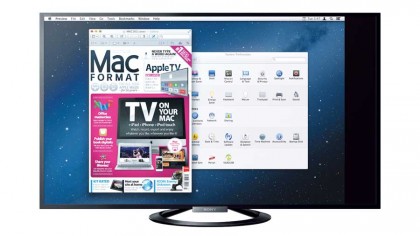Watch TV on your Mac: the definitive guide
The proper Apple TV isn't quite here yet, so why not watch TV on your existing Apple kit?
The iTunes Store has a huge catalogue of movies, including recent blockbusters and TV series. Most movies, though not all, can be both bought and rented. TV series can be bought as individual episodes or a 'box set.' And both movies and TV series come in standard and high definition.
If you're buying from a Mac, iPhone, iPod touch, or iPad, the movie or TV programme will download to your device. If you purchase from an Apple TV it will stream, but you can download it to another device later by clicking on the Purchased link in the iTunes Store.
Once your videos are in iTunes on your Mac they, along with stuff you've bought on the iTunes Store can be shared with any Mac, Apple TV, or iOS device on your network by clicking File > Home Sharing > Turn on Home Sharing in iTunes on the host Mac. This is the only way to share content bought on iTunes with other devices, as it is protected with Apple's FairPlay DRM.
If you've bought movies or TV programmes on iTunes on your Mac or Apple TV, you can download them directly to your iPad without having to re-purchase them. In the Videos app, tap Store, then at the bottom of the screen, Purchased. Tap Films or TV Series at the top of the screen, and then the cloud icon next to the programme or movie you want to download. Doing the same on the iPhone or iPod touch will only allow you to download music.
iTunes is also the conduit for transferring videos between your Mac and iOS device.
AirPlay mirroring
Reflect everything from one screen to another, as if by magic

AirPlay mirroring is a terrific innovation and one which games developers in particular have used to great effect. But what about video content on your iPhone, iPad, or Mac? The short answer is that it depends on a couple of things.
Sign up for breaking news, reviews, opinion, top tech deals, and more.
The first is your device. To mirror from an iPhone, you'll need either a 4S or 5. If you have an iPad, it will need to be an iPad 2 or later. The Mac can also mirror its display to Apple TV, but you'll need either a MacBook Air, iMac, or Mac mini that was released in mid-2011 or later, or a MacBook Pro launched in early 2011 or later, plus Mountain Lion. These hardware restrictions may seem harsh, but AirPlay mirroring needs on-GPU H.264 encoding and the older Macs just aren't up to the job.
Encoding the video on the CPU, particularly on older Macs, would put a strain on the processor, but one Mac app, AirParrot, manages to do it for multiprocessor Macs. Its developer says it has worked hard to optimise the encoding so that it doesn't hog too many processor cycles, but the older your Mac, the greater the strain it will put on it.
The other factor which dictates whether you can mirror video is the app from which you want to mirror. For example, BBC iPlayer and TED allow you to mirror content without a problem. But 4oD, ITV Player, and Demand 5 don't. 4oD supported mirroring until last year, but Channel 4 now explains that enabling AirPlay would require 'specific content rights, which we don't currently own.'
You can't hook up your iPad to your TV by HDMI cable and use 4oD either, for the same reason. Conversely, HBO's Go app, available only in the US, originally didn't support AirPlay mirroring, but it was enabled in its second version, which was launched in February.
Currently, AirPlay is one-way mirror. You can mirror the content of a display on a Mac or an iOS device on an Apple TV, but you can't, for example, mirror an iPad's display on a Mac, or vice versa. At least, not officially.
There are a couple of Mac apps which allow you to mirror an iOS device on a Mac. AirServer, despite its name, is one of those and acts as a receiver for mirrored content from an iPhone or iPad. It effectively fools the iOS device into thinking it's an Apple TV.
Another app, Reflector does a similar job. AirPlay isn't the only option for sending video wirelessly from an iOS device or Mac to your TV, however. YouTube and Netflix are reported to be working on an open-standard to do just that. Until them, there's Plair.
Plair promises to be 'AirPlay for everyone.' The hardware is a device which plugs into your TV's HDMI socket and connects to your Wi-Fi network. Once you've downloaded the app (available for OS X and iOS) you can send video streams from some websites to your television.
It doesn't support rights-protected content, so won't work with iTunes videos or 4oD, but streams from most TV networks and video sites should work.